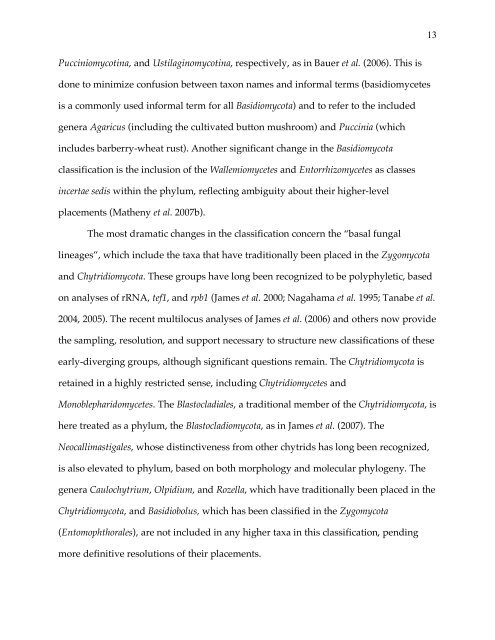Elsevier Editorial System(tm) for Mycological ... - Clark University
Elsevier Editorial System(tm) for Mycological ... - Clark University
Elsevier Editorial System(tm) for Mycological ... - Clark University
Create successful ePaper yourself
Turn your PDF publications into a flip-book with our unique Google optimized e-Paper software.
Pucciniomycotina, and Ustilaginomycotina, respectively, as in Bauer et al. (2006). This is<br />
done to minimize confusion between taxon names and in<strong>for</strong>mal terms (basidiomycetes<br />
is a commonly used in<strong>for</strong>mal term <strong>for</strong> all Basidiomycota) and to refer to the included<br />
genera Agaricus (including the cultivated button mushroom) and Puccinia (which<br />
includes barberry-wheat rust). Another significant change in the Basidiomycota<br />
classification is the inclusion of the Wallemiomycetes and Entorrhizomycetes as classes<br />
incertae sedis within the phylum, reflecting ambiguity about their higher-level<br />
placements (Matheny et al. 2007b).<br />
The most dramatic changes in the classification concern the “basal fungal<br />
lineages”, which include the taxa that have traditionally been placed in the Zygomycota<br />
and Chytridiomycota. These groups have long been recognized to be polyphyletic, based<br />
on analyses of rRNA, tef1, and rpb1 (James et al. 2000; Nagahama et al. 1995; Tanabe et al.<br />
2004, 2005). The recent multilocus analyses of James et al. (2006) and others now provide<br />
the sampling, resolution, and support necessary to structure new classifications of these<br />
early-diverging groups, although significant questions remain. The Chytridiomycota is<br />
retained in a highly restricted sense, including Chytridiomycetes and<br />
Monoblepharidomycetes. The Blastocladiales, a traditional member of the Chytridiomycota, is<br />
here treated as a phylum, the Blastocladiomycota, as in James et al. (2007). The<br />
Neocallimastigales, whose distinctiveness from other chytrids has long been recognized,<br />
is also elevated to phylum, based on both morphology and molecular phylogeny. The<br />
genera Caulochytrium, Olpidium, and Rozella, which have traditionally been placed in the<br />
Chytridiomycota, and Basidiobolus, which has been classified in the Zygomycota<br />
(Entomophthorales), are not included in any higher taxa in this classification, pending<br />
more definitive resolutions of their placements.<br />
13
















